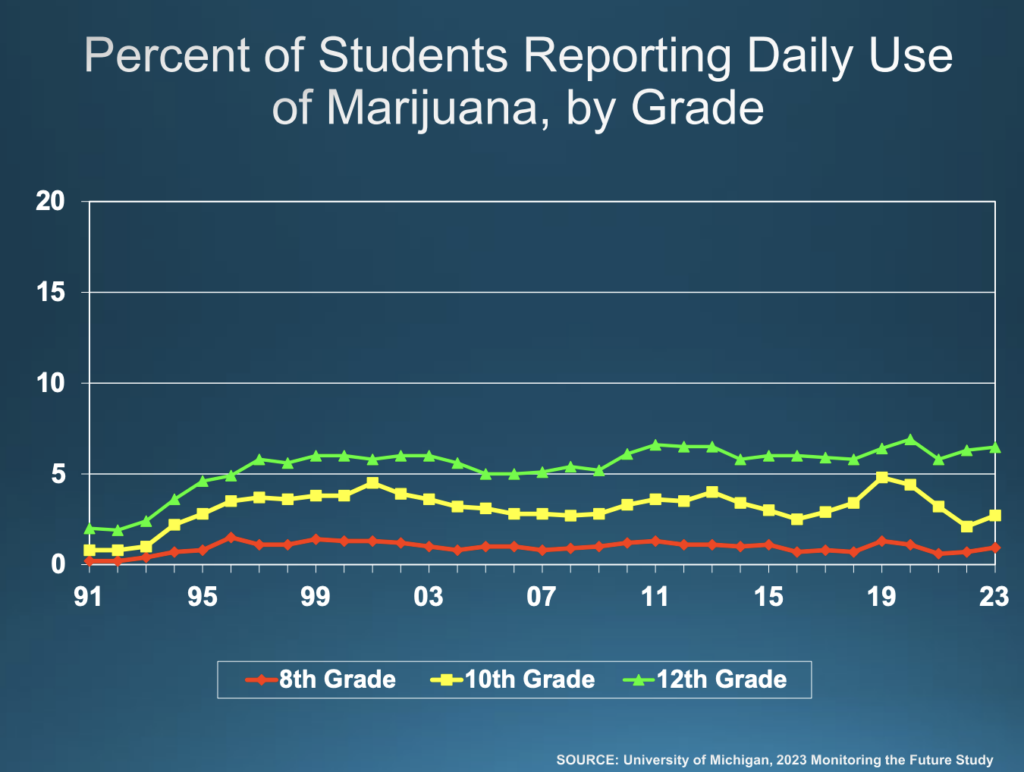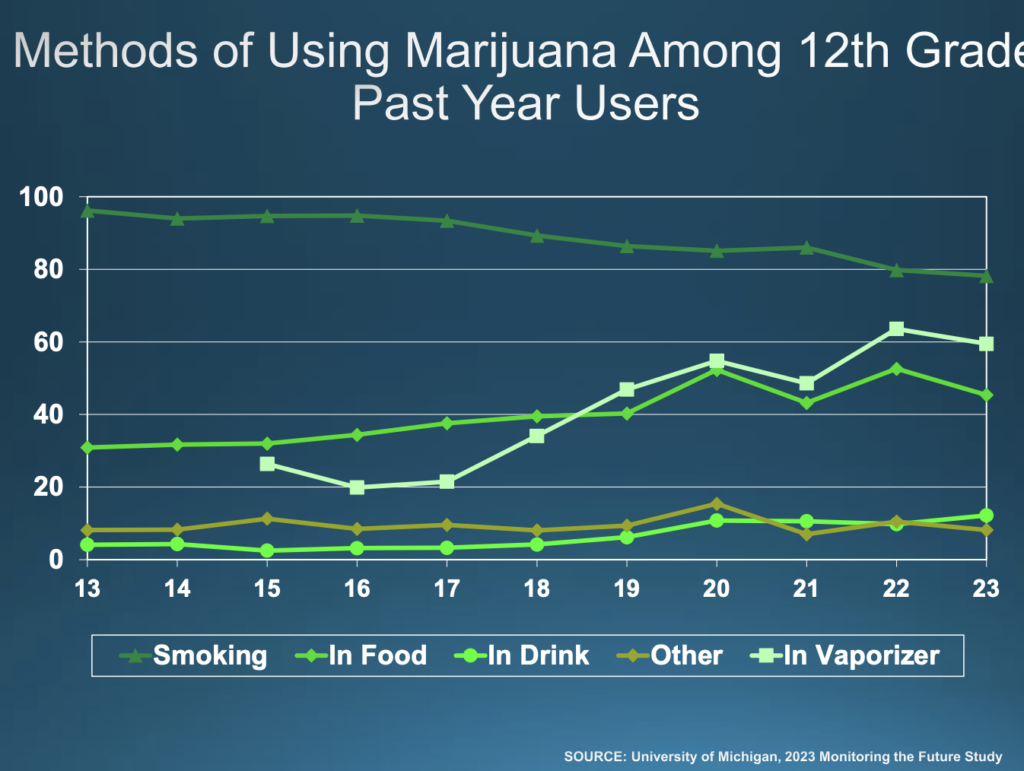State Marijuana Legalization Has ‘Not Really Impacted’ Teen Use, Federal Official Says As New Youth Survey Shows Stable Trends
FeaturedMarijuana IndustryMarijuana Industry News December 13, 2023 MJ Shareholders 0
Teen marijuana use has not increased “even as state legalization has proliferated across the country,” a federal health official said on Wednesday in announcing the latest data from an annual survey that again showed prohibitionist concerns about youth cannabis access have “not played out.”
The 2022 Monitoring the Future (MTF) survey—which is conducted by the University of Michigan with funding from the National Institute on Drug Abuse (NIDA)—found that rates of past-year cannabis use “remained stable for all three grades surveyed,” remaining below pre-pandemic usage levels even as more state marijuana markets opened and expanded for adults.
“There have been no substantial increases at all,” Marsha Lopez, chief of NIDA’s epidemiological research branch, said in response to a question from Marijuana Moment during a webinar on Wednesday. “In fact, they have not reported an increase in perceived availability either, which is kind of interesting.”
“So whatever is happening with adult-use [legalization] across the country has not really impacted the younger people according to the data here,” she said.

Via MTF.
The MTF survey, which also asked teens about use of delta-8 THC products for the first time, showed past-year marijuana use at 8.3 percent for eighth graders, 17.8 percent for 10th graders and 29 percent for 12th graders.
While 11 more states legalized marijuana from 2020 to 2022 (with variation in the implementation timeline), the survey data shows that the “liberalization of marijuana policies in states” are not translating into increased perceptions of availability among adolescents either, Lopez said. “In fact, that has been trending downward over the years.”
Further, there’s been “steadier declines in the perception of harm” of using cannabis “without the corresponding increases in use that we might expect as we have in the past.”
These trends are also being observed despite adult use of marijuana and certain psychedelics reaching “historic highs” in 2022, according to separate MTF data that was released earlier this year.
Advocates have long contested prohibitionist arguments that adult-use legalization would lead to increased underage use, arguing that establishing regulated markets where IDs are checked and other safeguards are put in place effectively restricts youth access. And that’s been borne out in data from multiple studies.
There’s also a “relatively low prevalence” of daily cannabis use, which has been “remarkably steady for the last 10 years,” Lopez said on Wednesday. That’s notable considering that the first state recreational marijuana markets opened about a decade ago.

Via MTF.
While the survey data isn’t representative of individual states, NIDA and the University of Michigan did compare various marijuana-related indicators from teens living in states where cannabis is illegal and where it’s legal for medical use. The survey found no statistically significant difference in rates of past-year use across all grades regardless of state medical marijuana laws.
For 10th and 12th graders, there were also no significant differences in perceptions of risk, availability or disapproval of use.

Via MTF.
Eighth grade students living in states with medical cannabis were somewhat less likely to view use as risky and say there’s slightly greater availability, though their use rates were not significantly higher.
Meanwhile, the majority of teens who use marijuana still say they’re smoking it, the survey found. However, there’s been a gradual shift in methods of consumption, with more youth vaping or using edibles.

Via MTF.
For the first time, the MTF 2022 survey also features data on teen use of intoxicating delta-8 THC products, which are typically derived from federally legal hemp and sold in a largely unregulated market, though some states have enacted restrictions or bans.
It found that 11.4 percent of 12th graders reported past-year use of delta-8 THC products. NIDA said future surveys will ask eighth and 10th graders about their use of the cannabinoid too. Richard Miech, team lead of the MTF, said in a press release that researchers were “surprised to see use levels this high among 12th graders.”
“Moving forward, as policies and access to this drug change, it will be important to continue to monitor use of this drug among teens,” he said. For what it’s worth, a separate federally funded study published this month signaled that states prohibiting marijuana may “unintentionally promote” the use of delta-8 products.
Though the MTF surveys have shown that youth cannabis consumption has remained stable, another analysis from the Centers for Disease Control and Prevention (CDC) found that rates of current and lifetime cannabis use among high school students have continued to drop amid the legalization movement.
What was especially notable about the data is that it found high school student use was trending up from 2009-2013—before legal marijuana dispensaries started opening—but has been generally on the decline since then. The first state recreational legalization laws were approved by voters in 2012, with regulated retail sales beginning in 2014.
A study of high school students in Massachusetts that was published last month found that youth were no more likely to use marijuana after legalization, though more students perceived their parents as cannabis consumers after the policy change.
A separate NIDA-funded study that was published in the American Journal of Preventive Medicine last year also found that state-level cannabis legalization is not associated with increased youth use.
The study demonstrated that “youth who spent more of their adolescence under legalization were no more or less likely to have used cannabis at age 15 years than adolescents who spent little or no time under legalization.”
Yet another federally funded study from Michigan State University researchers that was published in the journal PLOS One last year found that “cannabis retail sales might be followed by the increased occurrence of cannabis onsets for older adults” in legal states, “but not for underage persons who cannot buy cannabis products in a retail outlet.”
A recent Gallup poll, meanwhile, found that fully half of all American adults have tried marijuana at some point in their lives, with rates of active cannabis consumption surpassing that of tobacco. Broken down by age, 29 percent of those 18–34 say they currently smoke marijuana, though that’s not necessarily representative of overall cannabis use, because the survey only asked about smoking and not other modes of consumption such as edibles, vaping or tinctures.
Photo courtesy of Carlos Gracia.
MJ Shareholders
MJShareholders.com is the largest dedicated financial network and leading corporate communications firm serving the legal cannabis industry. Our network aims to connect public marijuana companies with these focused cannabis audiences across the US and Canada that are critical for growth: Short and long term cannabis investors Active funding sources Mainstream media Business leaders Cannabis consumers












No comments so far.
Be first to leave comment below.